Understanding radio pulsars from a broad-band perspective (Lucy Oswald)
Since their discovery in 1967, pulsars have been used to push the boundaries of our understanding of the Universe, through precision tests of General Relativity and the search for gravitational waves. Despite this, there remain many unanswered questions about the behaviour of the pulsars themselves. In recent years however, new and upgraded telescopes have given us a broad-band perspective of pulsar radio emission. I will present a summary of some new insights that these broad-band observations bring to our understanding of radio pulsars, in terms of the radio beam structure, pulsar polarization behaviour and the properties of the interstellar medium. I will also discuss what progress in understanding is being made possible through large-scale surveys of pulsars with these instruments.
Using planetary nebulae as tracers of galaxy and intra-group light kinematics: the case of M105 (Johanna Hartke)
How are the extended and low-surface brightness halos of early-type galaxies built up, and which role does their environment play in their evolution? While resolved stellar populations from deep HST imaging are excellent tracers of nearby galaxy halos in pencil-beam fields, it is challenging to use them as tracers of extended haloes in galaxies or of the diffuse intracluster and intra-group light (IGL) at large spatial scales. Instead, at these distances, Planetary Nebulae (PNe) are a viable alternative. I will showcase our recent work on the early-type galaxy M105 and how we used PNe to trace and characterize the transition from the galaxy’s halo into the IGL of the Leo I group.
The last 10 billion years of the Universe structure growth (Carlos Garcia-Garcia)
The current constraints on the S_8 parameter are subject of debate. Cosmic shear observations show a lower value than that predicted by Planck. For instance, KiDS finds results 3\sigma away from Planck's value and data from DESY1 also points in the same direction. In this talk I will show the data driven reconstruction of the evolution of the S_8(z) parameter from a combination of 6 different data sets that include galaxy clustering, weak lensing and CMB lensing (with DESY1 and KiDS-1000 among them). I will show that these data constrain the amplitude of fluctuations in the range 0.2 \lesssim z \lesssim 2 and give consistent growth histories. Furthermore, I will show that in the range 0.2 \lesssim z \lesssim 0.7 current data prefer a lower value than that predicted by Planck and that it is mostly driven by cosmic shear observations.

